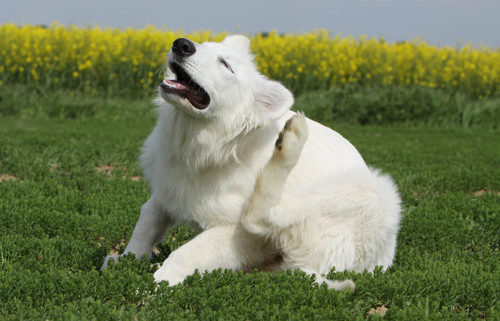For pets like dogs and cats, flea and tick problems can surge in the late summer and fall. Knowing how to recognize these disease-bearing pests and knowing what to do to protect your pet can help keep you and your pet safe from this problem during the autumn months.
All About Fleas
Fall is a time when fleas attach themselves to pets in large numbers. Temperatures at around 70 degrees are the ideal temperature for fleas to hatch and grow, and the winter coats that pets begin to grow in fall make the perfect spot for fleas to live and reproduce. If you’re a pet owner at this chilly time of year, this is a time when it’s very important to stay diligent with your pet’s flea prevention program.
- Where they come from: Fleas can spread from animal to animal contact, and can also attach themselves to your pet from your lawn or garden. Fleas live in piles of organic debris like leaves and twigs, and can be found in the upholstery and carpet of homes where infected pets live.
- How to prevent fleas: There are many things you can do to protect your pet from fleas in the fall. Maintain your lawn. Keep your grass cut, and burn or dispose of leaves in a timely fashion. Keep your pet away from unfamiliar animals, and be careful about purchasing used chairs or carpet. Flea collars and flea-preventatives can also be effective, so talk to your pet’s veterinarian about the best flea-preventatives for your pet.
- How to tell if your pet has fleas: Pets who have fleas will scratch their skin obsessively, especially in the folds of the skin, like the area between the legs and the body. Pets with fleas may scratch themselves so much that they develop skin infections and hot spots.
- How to eliminate fleas: If your pet becomes infected with fleas, use medicated shampoos and flea-removing combs to rid your pet of these pests. Finally, wash all infected carpet and upholstery in hot water, and treat everything that can’t be washed with flea powder.
All About Ticks
Ticks that bite in fall can carry Lyme disease, so preventing tick bites is an important part of keeping your pet safe and healthy. Pets get bitten by ticks when they’re outside, so it’s important to check your pet as soon as he or she comes in. Feel your pet’s skin for a small, hard lump.
- Where they come from: Ticks are found in lawn debris, like leaf piles, and tall grasses.
- How to prevent ticks: Maintain your yard. Rake up piles of leaves and dispose of them in a timely fashion. Keep your grass trim and remove the clippings quickly.
- How to eliminate ticks: Ticks can be removed with tweezers. Grip the tick with the tweezers and pull straight up. Do not allow the head of the tick to remain in your pet’s skin, as this can cause infection.
Join the National Animal Supplement Council
The National Animal Supplement Council promotes animal wellness through healthy supplements and dietary choices. At the NASC, we’re committed to our goals. Like you, we want your pet to be healthy! To join our ranks and help us promote animal wellness, click here.


